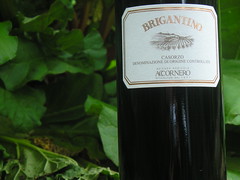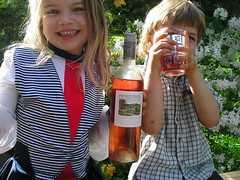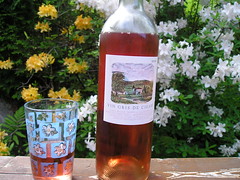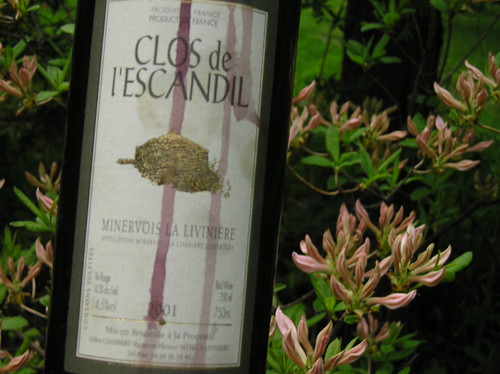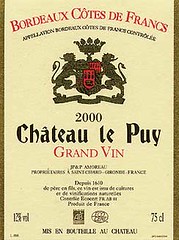 Biodynamic in Bordeaux
Biodynamic in Bordeaux
The Seemingly Ageless Château le PuyWhile the
debate over the merits of biodynamic agriculture continues, one cannot argue about the quality and uniqueness of many of the wines produced by those winemakers who follow this discipline. The wines of Leroy, Joly, Weinbach, Ostertag, Gauby, Lapierre, to name but a few, are some of the finest examples of their respective regions. The real question is whether the quality of these wines are a product of bio-d, or simply due to that unique combination of winemaker skill, attentiveness, soil and climate.
While biodynamics is gaining adherents the world over, staid and conservative Bordeaux has so far resisted the temptation to hang and bury plant-stuffed deer bladders. However, there is one winemaker who has taken that leap of faith, embracing not only bio-dynamics but also a more organic approach to vinification via the use of indigenous yeasts, little or no sulphur dioxides, no fining or filtration.
The witch in question is Jean-Pierre Amoreau of Château le Puy, a 25 hectare vineyard in the Côtes de Francs region of Bordeaux. It shares the same rocky plateau as Saint-Emilion and Pomerol, with his site sitting atop the ‘Côteau des Merveilles,’ a name which pays homage to the quality of the wines produced at a Château which has been in operation since 1610. His wines are dominated by very ripe merlot with small percentages of Cabernet Sauvignon and a touch of Carménère, and are marked by a bright acidity which offers an exemplary freshness and length.
Amoreau scoffs at his fellow countrymen who have succumbed to what he refers to as the whims of the export market and their critics. While he uses Michel Rolland’s laboratory for analysis, he refers to Rolland as a brilliant chemist, someone who understands marketing more than wine. He in unabashedly Bordelais, believing that while his wines should be approachable in the first few years in bottle, their destiny is to be passed on to later generations, a snapshot of the year they were made and of the person who made them.
Before I launch into a tasting that went as far back as 1955, it should be noted that these are $23 bottles, not the ‘mortgage your house and let the kids eat lentils’ first-classed growths. I was shocked at not only how the bottles showed the same exemplary lineage, but also at how they aged with such grace and elegance. Thanks to Erwan and the gang at AOC for arranging a great tasting and dinner.
Château le Puy 2001 (
saq…$23)
Soft and delicate red fruits with a hint of truffle and held up by very ripe tannins. A great bottle from an underrated vintage.
Château le Puy 2000
I found the balance slightly off, with a tart black cherry aftertaste that cut into the expansiveness and creamy-mouth feel that was so sexy in the 2001.
Château le Puy 1989
A beautiful bouquet that combined dark plums with herbs. It had a similar touch of tart cherry as the 2000 but in this context, it added freshness that was a beautiful counterbalance to the darker, slightly jammy fruit.
Château le Puy 1970
Remember, this wine costs $25! This is how Bordeaux should be drunk. A generous bouquet that combined herbs, tobacco with a hint of leather was followed by a profound fruitiness that evoked the same bright plum and tart cherry of younger vintages but in a richer and more elegant framework.
Château le Puy 1967
The first to have signs of age, it still had that signature acidity but the fruit was a touch cooked (think of port). If you like the style, and lots do, then it was great. I dumped my glass and took a big boy gulp of the 1970.
Château le Puy 1955
It smelled and tasted younger than the ’67, except for hints of strawberry and red cherries that gave the wine a certain softness unfound in the other vintages. Very pretty and again, that brilliant acidity kept the ensemble fresh.
Château le Puy 2003, Cuvée Barthélemy (saq…$60)
With no added sulfur, the Barthélemy is one of the finer examples of wines made in this model. Not reductive in the least, it had a ton of fruit held up by soft, round tannins. It made me kinda think of a young Brigitte Bardot for some reason. Ready to drink and will be available at the SAQ in the coming months.
Château le Puy 2001, Cuvée Barthélemy
One of the problems with no sulfur wines is the risk of oxidation. While the ’03 was perfect, I found the 2001 slipped a bit into that porto fruit area. Very drinkable with notes of cassis and almost a Languedoc type garrigue bouquet.
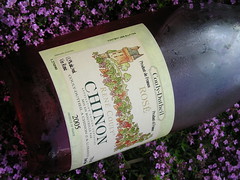 Garden Rosé Tasting #6
Garden Rosé Tasting #6